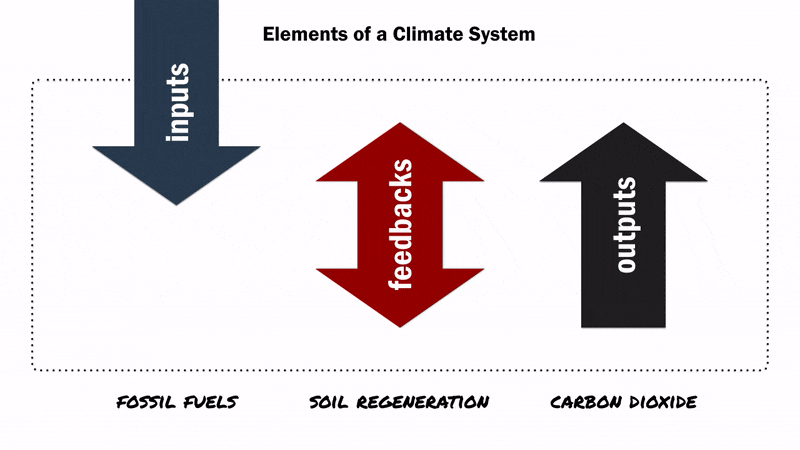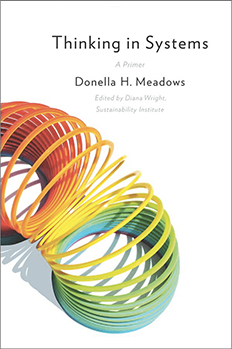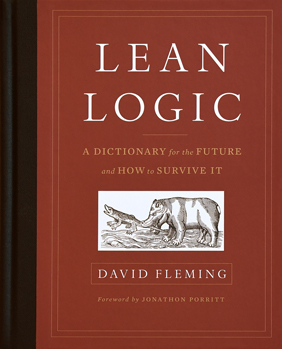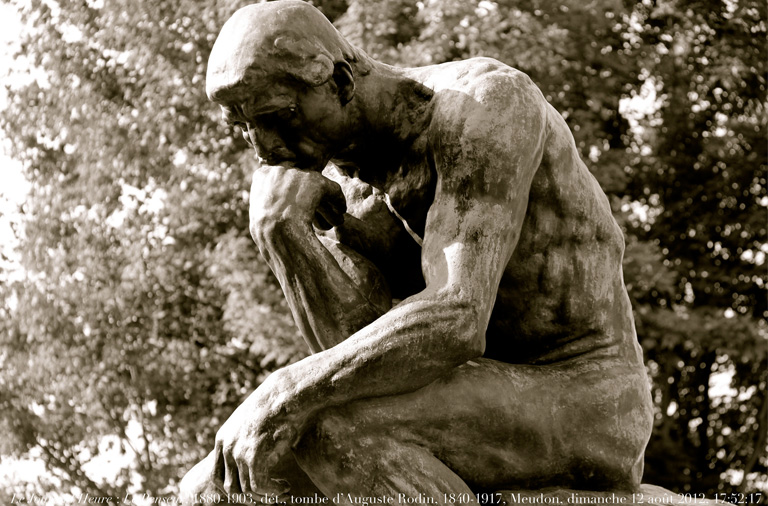As a writer focused on the global sustainability crisis, I’m often asked how to deal with the stress of knowing—knowing, that is, that we humans have severely overshot Earth’s long-term carrying capacity, making a collapse of both civilization and Earth’s ecological systems likely; knowing that we are depleting Earth’s resources (including fossil fuels and minerals) and clogging its waste sinks (like the atmosphere’s and oceans’ ability to absorb CO2); knowing that the decades of rapid economic growth that characterized the late 20th and early 21st centuries are ending, and that further massive interventions by central banks and governments can’t do more than buy us a little bit more time of relative stability; knowing that technology (even renewable energy technology) won’t save our fundamentally unsustainable way of life.
In the years I’ve spent investigating these predicaments, I’ve been fortunate to meet experts who have delved deeply into specific issues—the biodiversity crisis, the population crisis, the climate crisis, the resource depletion crisis, the debt crisis, the plastic waste crisis, and on and on. In my admittedly partial judgment, some of the smartest people I’ve met happen also to be among the more pessimistic. (One apparently smart expert I haven’t had opportunity to meet yet is 86-year-old social scientist Mayer Hillman, the subject of this recent article in The Guardian.)
In discussing climate change and all our other eco-social predicaments, how does one distinguish accurate information from statements intended to elicit either false hope or needless capitulation to immediate and utter doom? And, in cases where pessimistic outlooks do seem securely rooted in evidence, how does one psychologically come to terms with the information?
Systems Thinking
First, if you want to have an accurate picture of the world, it’s vital to pay attention to the connections between things. That means thinking in systems. Evidence of failure to think in systems is all around us, and there is no better example than the field of economics, which treats the environment as simply a pile of resources to be plundered rather than as the living and necessary context in which the economy is grounded. No healthy ecosystems, no economy. This single crucial failure of economic theory has made it far more difficult for most people, and especially businesspeople and policy makers, to understand our sustainability dilemma or do much about it.
Unsurprisingly, perhaps, the field in which systems thinking is most highly developed is ecology—the study of the relationships between organisms and their environments. Since it is a study of relationships rather than things in isolation, ecology is inherently systems-oriented.
Systems thinking has a pre-history in indigenous thought (Mitákuye Oyás’iŋ, or “All are related,” is a common phrase in the Lakota language). But as a formal scientific pursuit it emerged only during the latter part of the twentieth century. Previously, Western scientists often assumed that they could understand systems just by analyzing their parts; however, it gradually became clear—in practical fields from medicine to wildlife management to business management—that this often led to unintended consequences.
In medicine, it is understood that treating diseases by managing symptoms is not as desirable as treating the disease itself; that’s partly because symptomatic treatment with pharmaceuticals can produce side effects that can be as distressing as the original disease symptoms. Take a pill and you may feel better for a while, but you may soon have to deal with a whole new slew of aches, rashes, sleep problems, mood swings, or digestive ailments. Further, truly curing a disease often involves addressing exposure to environmental toxins; or lifestyle choices including poor nutrition, smoking, lack of exercise, or job-related repetitive stress injuries—all of which are systemic issues that require treating the whole person and their environment, not just the symptoms, or even just the disease in isolation.
In order to address systemic problems we need to understand what systems are, and how to intervene in them most effectively.
All systems have:
- Boundaries, which are semi-permeable separations between the inside and outside of systems;
- Inputs of energy, information, and materials;
- Outputs, including work of various kinds, as well as waste heat and waste materials;
- Flows to and from the environment;
- Stocks of useful nutrients, resources, and other materials; and
- Feedbacks, of which there are two kinds: balancing or negative, like a thermostat; and self-reinforcing or positive, which is the proverbial vicious circle. Systems need balancing feedback loops to remain stable and can be destabilized or even destroyed by self-reinforcing feedback loops.
The human body is a system that is itself composed of systems, and the body exists within larger social and ecological systems; the same could be said of a city or a nation or a company. A brick wall, in contrast, doesn’t have the characteristics of a system: it may have a boundary, but there are few if any meaningful ongoing inputs and outputs, information flows, or feedbacks.
The global climate is a system, and climate change is therefore a systemic problem. Some non-systems thinkers have proposed solving climate change by putting chemicals in the Earth’s atmosphere to manage solar radiation. Because this solution addresses only part of the systemic problem, it is likely to have many unintended consequences. Systems thinking would suggest very different approaches—such as reducing fossil fuel consumption while capturing and storing atmospheric carbon in replanted forests and regenerated topsoil. These approaches recognize the role of inputs (such as fossil fuels), outputs (like carbon dioxide), and feedbacks (including the balancing feedback provided by soil carbon flows).

In some cases, a systemic approach to addressing climate change could have dramatic side benefits: regenerative agriculture would not just sequester carbon in the soil, it would also make our food system more sustainable while preserving biodiversity. Interventions based in systems thinking often tend to solve many problems at once.
Donella Meadows, who was one of the great systems thinkers of the past few decades, left us a brilliant essay titled “Leverage Points: Places to Intervene in a System.” There are places within every complex system where “a small shift in one thing can produce big changes in everything.” Meadows suggested that these leverage points have a hierarchy of effectiveness. She said that the most powerful interventions in a system address its goals, rules, and mindsets, rather than parameters and numbers—things like subsidies and taxes. This has powerful implications for addressing climate change, because it suggests that subsidizing renewable energy or taxing carbon is a fairly weak way of inducing systemic change. If we really want to address a deeply rooted, systemic problem like climate change, we may need to look at our society’s most fundamental paradigms—like, for example, the assumption that we must have continual economic growth.
We intuitively know that systems are more than the sum of their parts. But digging deeper into the insights of systems theory—going beyond the basics—can pay great dividends both in our understanding of the world, and in our strategic effectiveness at making positive change happen. A terrific resource in this regard is Meadows’s book Thinking in Systems.
In addition to imparting general understanding about the nature of systems, the book teaches readers how to  interpret and make system dynamics diagrams—to which I was first exposed in 1972 in that cornerstone of systems literature, The Limits to Growth. One of the virtues of system dynamics diagrams is that they can aid in the creation of computerized system models— several extremely useful examples of which appear on the website www.ClimateInteractive.org. It features two tools: C-ROADS and En-ROADS, system dynamics models that enable the user to see the potential impact of various climate and energy policies. Tweak the variables and watch the outcomes.
interpret and make system dynamics diagrams—to which I was first exposed in 1972 in that cornerstone of systems literature, The Limits to Growth. One of the virtues of system dynamics diagrams is that they can aid in the creation of computerized system models— several extremely useful examples of which appear on the website www.ClimateInteractive.org. It features two tools: C-ROADS and En-ROADS, system dynamics models that enable the user to see the potential impact of various climate and energy policies. Tweak the variables and watch the outcomes.
Systems thinking often tends to lead to a more pessimistic view of our ecological crisis than thinking that focuses on one thing at a time, because it reveals the shortcomings of widely touted techno-fixes. But if there are truly useful strategies to be found, systems thinking will reveal them.
Critical Thinking
Human thought is rooted partly in words, partly in emotions, and partly in the body states (whether you feel alert, sleepy, hungry, agitated, etc.) that may accompany or give rise to emotions; another way of saying this is that our thought processes are partly conscious but mostly unconscious. In our conscious lives we are immersed in a soup of language, which often simply expresses judgments, intuitions, and observations that emerge from unconscious thought. But thought that’s expressed in language has great potential. Using language (including mathematics), we can assess the validity of statements about the world, then build upon proven statements until we ultimately achieve comprehensive scientific understandings and the capacity to manipulate reality in new ways (to build a bridge, for example, or land a probe on a distant asteroid, or update an app).
Of course, language can be powerful in another way. Some of us use language to persuade, confuse, or mislead others so as to gain social or economic power. Appeals to unconscious prejudices, including peer group-think, are frequently employed to sway the masses. The best protection against being the subject of verbal manipulation is the ability to use language to distinguish logic from illogic, truth from untruth. Critical thinking helps us separate information from propaganda. It can help us think more clearly and productively.
One way to approach critical thinking is through the study of logic—including formal logic (which builds conclusions almost mathematically, using syllogisms), informal logic (which also considers content, context, and delivery), and fuzzy logic (which recognizes that many qualities are subjective or matters of degree). Most of our daily thinking consists of informal and fuzzy logic.
The study of formal logic starts with learning the difference between deductive reasoning (which proceeds from a general principle to a special case, sometimes referred to as “top-down reasoning”) and inductive reasoning (which makes broad generalizations from specific observations, also called “bottom-up reasoning”).
Both deductive and inductive forms of reasoning can be misapplied. One might deduce from the general rule “human history is a grand narrative of progress” that therefore humanity will successfully deal with the ecological challenges of the 21st century and emerge smarter, wealthier, and more virtuous than ever. Here the problem is that the general rule is laden with value judgments and subject to many exceptions (such as the collapse of various historical civilizations). Inductive reasoning is even more perilous, because there is always the danger that specific observations, from which one is drawing general conclusions, are incomplete or even misleading (economic growth has occurred in most years since World War II; therefore, economic growth is normal and can be expected to continue, with occasional brief setbacks, forever).
 While learning the rules of formal logic can help in honing one’s critical thinking, it’s just as useful to familiarize oneself with logical fallacies—which include circular reasoning, name-calling, hasty generalization, stereotyping, the either-or fallacy, and appeal to the bandwagon. These days, that’s a fair description of much of the content on social media. Learn to spot these fallacies in political discourse; but, better yet, learn to catch yourself using them.
While learning the rules of formal logic can help in honing one’s critical thinking, it’s just as useful to familiarize oneself with logical fallacies—which include circular reasoning, name-calling, hasty generalization, stereotyping, the either-or fallacy, and appeal to the bandwagon. These days, that’s a fair description of much of the content on social media. Learn to spot these fallacies in political discourse; but, better yet, learn to catch yourself using them.
My favorite book on logic and its fallacies is Lean Logic by the late David Fleming, a British economist-philosopher who cofounded what eventually became the Green Party in the UK, and who originated the idea of Tradable Energy Quotas. There’s no simple way to sum up Fleming’s book, which is organized as a dictionary. Among many other things, it explores a wide range of logical fallacies—especially as they relate to our sustainability crises—and does so in a way that’s playful, artful, and insightful.
One of my favorite sections of the book is a four-page collection of ways to cheat at an argument. Here are just a few of the entries, chosen mostly at random:
Absence. Stop listening.
Abstraction. Keep the discussion at the level of high-flown generality.
Anger. Present it as proof of how right you are.
Blame. Assume that the problem is solved when you have found someone to blame.
Bullshit. Talk at length about nothing.
Causes. Assume that an event which follows another event was therefore caused by it.
Evil motive. Explain away the other side’s argument by the brilliance of your insight about their real intentions.
False premise. Start with nonsense. Build on it with meticulous accuracy and brilliance.
Old hat. Dismiss an argument on the grounds that you have disregarded it before.
Critical thinking should not necessarily elevate reason above intuition. Remember: most thought is unconscious and emotion-driven—and will continue to be, no matter how rigorously we analyze our verbal and mathematical expressions of thought. Just as we seek coherence and consistency in our conscious logic, we should seek to develop emotional intelligence if we hope to contribute to a society based on truth and conviviality. Lean Logic reveals on almost every page its author’s commitment to this deeper concept of critical thinking. Here’s one illustrative entry:
Reasons, The Fallacy of. The fallacy that, because a person can give no reasons, or only apparently poor reasons, her conclusion can be dismissed as wrong. But, on the contrary, it may be right: her thinking may have the distinction of being complex, intelligent and systems-literate, but she may not yet have worked out how to make it sufficiently clear and robust to objections to survive in an argument.
As politics becomes more tribal, critical thinking skills become ever more important if you want to understand what’s really going on and prevent yourself from becoming collateral damage in the war of words.
Personal Resilience
Let’s return to the premise of this essay. Suppose you’ve applied systems thinking and critical thinking to the information available to you about the status of the global ecosystem and have come to the conclusion that we are—to use a technical phrase—in deep shit. You want to be effective at helping minimize risk and damage to ecosystems, humanity, yourself, and those close to you. To achieve this, one of the first things you will need to do is learn to maintain and use your newfound knowledge without becoming paralyzed or psychologically injured by it.
Knowledge of impending global crisis can cause what’s been called “pre-traumatic stress disorder.” As with other disorders, success in coping or recovery can be enhanced through developing personal or psychological resilience. Fortunately, psychological resilience is a subject that is increasingly the subject of research.
Some people bounce back from adversity relatively easily, while others seem to fall apart. The reason doesn’t seem to have much to do with being more of an optimist than a pessimist. Research has shown that resilient people realistically assess risks and threats; studies suggest that in some ways pessimists can have the advantage. What seems to distinguish resilient people is their use of successful coping techniques to balance negative emotions with positive ones, and to maintain an underlying sense of competence and assurance.
Researchers have isolated four factors that appear critical to personal psychological resilience:
- The ability to make realistic plans and to take the steps necessary to follow through with them;
- A positive self-concept and confidence in one’s strengths and abilities;
- Communication and problem-solving skills; and
- The ability to manage strong impulses and feelings.
An important question: To what degree is psychological resilience based on inherited or innate brain chemistry, or childhood experiences, versus learned skills? We each have a brain chemistry that is determined partly by genetic makeup and partly by early life experience. Some people enjoy a naturally calm disposition, while others have a hair-trigger and are easily angered or discouraged. In seeking to develop psychological resilience, it’s important to recognize and deal with your personal predispositions. For example, if you find that you are easily depressed, then it may not be a good idea to spend hours each day glued to a computer, closely following the unraveling of global ecological and social systems. Don’t beat yourself up for getting depressed; just learn to recognize your strengths and limits, and take care of yourself.
Nevertheless, research suggests that, regardless of your baseline temperament, you can make yourself more psychologically resilient through practice. The American Psychological Association suggests “10 Ways to Build Resilience,” which are:
- Maintain good relationships with close family members, friends and others.
- Avoid seeing crises or stressful events as unbearable problems.
- Accept circumstances that cannot be changed.
- Develop realistic goals and move towards them.
- Take decisive actions in adverse situations.
- Look for opportunities of self-discovery after a struggle with loss.
- Develop self-confidence.
- Keep a long-term perspective and consider the stressful event in a broader context.
- Maintain a hopeful outlook, expecting good things and visualizing what is wished.
- Take care of your mind and body, exercise regularly, and pay attention to your needs and feelings.
These recommendations are easier said than done. Learning new behaviors, especially ones that entail changing habitual emotional responses to trigger events, can be difficult. The most effective way to do so is to find a way to associate a neurotransmitter reward with the information or behavior being learned. For example, if you are just beginning an exercise regimen, continually challenge yourself to make incremental improvements that are just barely within your reach. This activates the dopamine reward circuits in your brain.
Psychological resilience may also entail learning to deal with grief. Awareness of species extinctions, habitat destruction, and the peril to human beings from climate change naturally evokes grief, and unexpressed grief can make us numb, depressed, and ineffective. It’s helpful therefore to find a safe and supportive environment in which to acknowledge and express our grief. Joanna Macy, in her “work that reconnects,” has for many years been hosting events that provide a safe and supportive environment for grief work.
Personal resilience extends beyond the psychological realm; developing it should also include identifying and learning practical skills (such as gardening, small engine maintenance, plumbing, cooking, natural building, primitive technology, and wilderness survival skills). Knowing practically how to take care of yourself improves your psychological state, as well as making you more resilient in physical terms.
Further, your personal resilience will be greatly enhanced as you work with others who are also blessed (or burdened) with knowledge of our collective overshoot predicament. For many years we at PCI have been assisting in the formation of ongoing communities of reflection and practice such as Transition Initiatives. If that strategy makes sense to you, but you don’t have a Transition group close by, you might take the Think Resilience course and then host a discussion group in your school, home, or public library.
Systems thinking, critical thinking, and personal resilience building don’t, by themselves, directly change the world. However, they can support our ability and efforts to make change. The key, of course, is to apply whatever abilities we have—in community resilience building, ecological restoration, or efforts to resist the destruction of nature and the exploitation of human beings. As we remain open to learning, action presents opportunities for still more learning, in the form of what systems thinkers would call balancing feedback. We test what we think we know, and discover new things about the world and ourselves. It’s a life-long process.
Even if we do all we can, there is no guarantee that problems will be solved, extinctions prevented, collapse forestalled. But paralysis only guarantees the very worst outcome. In the words of the Bhagavad Gita, “The wise should work, without attachment to results, for the welfare of the world.” Act from love with the best understanding you have, and always seek to improve your understanding. It’s all that any of us can do.
Feature Image Credit: Renaud Camus, c/o Flickr: https://www.flickr.com/photos/renaud-camus/8434440715/








